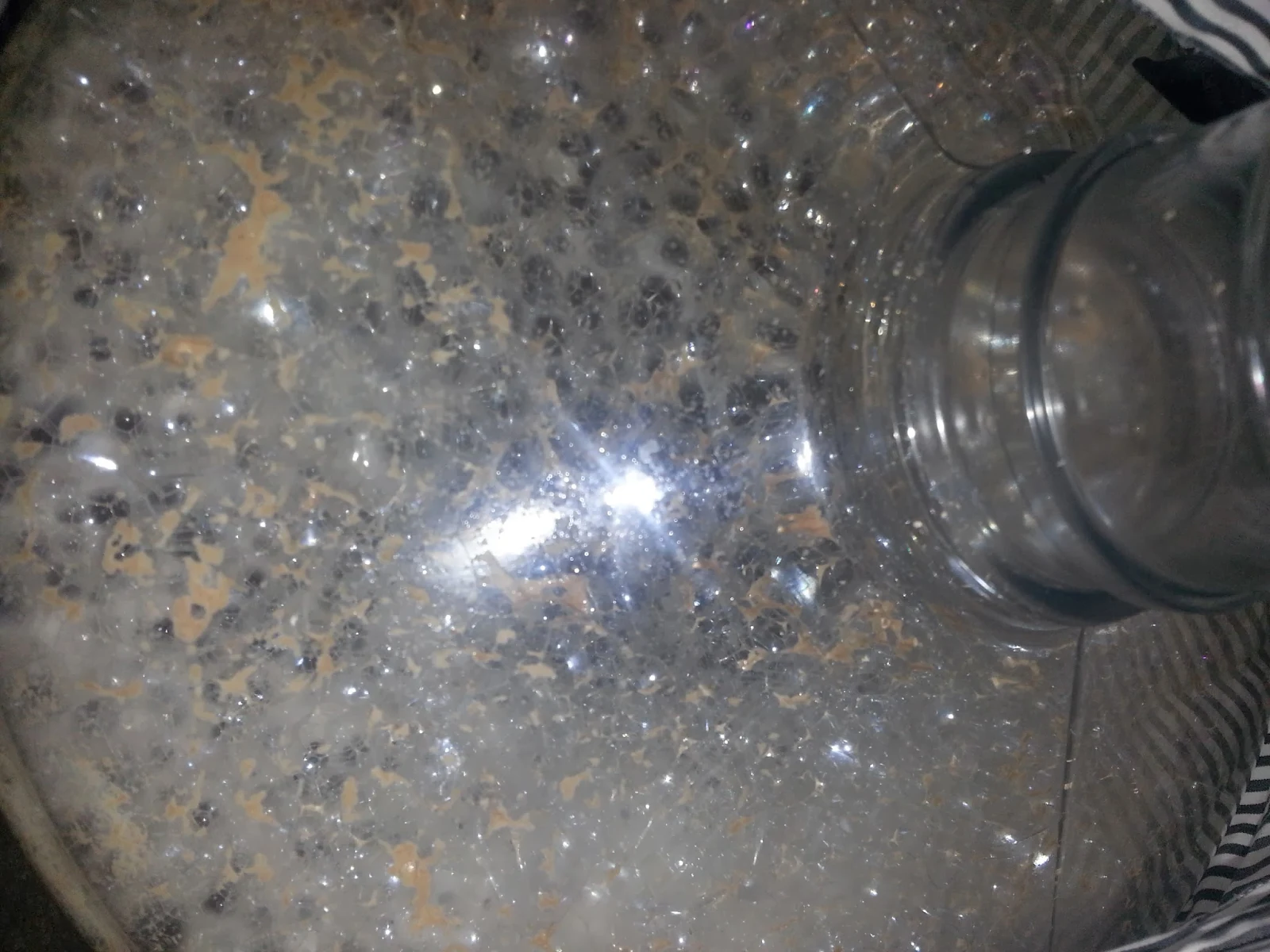The first day didn't show much activity so we'll skip ahead and talk about day 2.
Day 2
See all the specs? Those are alive. I mean, they are something growing. I used the flash on this picture, as you can tell, which highlighted the specs. If you look carefully you can see that some of the specs are white and some are a light tan color, like yeast color. The light tan specs are actually growing on the sides of the carboy where wort splashed up during transit. The white specs are actually on the surface on the beer. They are individually about the size of dried yeast cells, which makes me think it's sort sort of yeast. The wort is slightly murky and hazy, which suggests there is also bacterial growth within the depths of the wort.
Aroma is mostly fresh wort but there is a murky, funky edge to it.
Day 3
Is it possible my picture taking is getting worse?
No significant changes today. Whatever is growing on top is multiplying in numbers and getting more active. Pressure is definitely building up in the fermentor as some bubbles are appearing in the airlock. No change in aroma and no other change in appearance. The beer is still fairly murky under the surface.
Day 4
No, I didn't miss any days. This is really the evening of day four. Late last night whisps of white started showing up on the surface. By the this morning the foam was starting to appear. Now this is a full surface of fluffy white foam about half an inch thick. There is some slow bubbling in the airlock so there is some kind of fermentation going on. I'm not sure what is driving fermentation right now (my guess, based on time estimates and that dreaded chart is that it is bacterial) but it sure doesn't have the appearance of the tan stuff on the surface before, which was the usual color of yeast krausen. This stuff is snow white.
Activity is growing in the krausen on top. The foam is full of extremely large bubbles and it's now about three inches above the top of the liquid itself. The beer underneath is still the same murky consistency. Not sure if that is just a starchy haze or bacterial haze. Who knows.
Day 6
The big bubbles are gone, having dropped out mid-day. What's left now is a fairly flat level of white foam. It's the same sort of foam you see on the top of a saccharomyces fermentation before the krausen breaks out. It looks like the initial wave of fermentation has come to an end and something else is about to start taking over the beer.
Day 7
With some of that krausen residue on the roof of the carboy it's getting harder to get a good shot of the surface of the beer, so I apologize for the crappy picture here. It basically looks the same as it did the day before: light coating of white foam. It appears something is preparing to take over fermentation. It should be about time for yeast to start driving fermentation.
Summary for the Week
Glad to see there was some activity this week. If you disregarded the first day on inactivity then this week looked similar to what you would see in a regular beer fermentation (yeast growth followed by krausen) but in slow motion. What took a day or two here would normally occur over hours with a healthy pitch of saccharomyces. The other major difference is that after krausen drops in a regular beer you would see the beer start to clear out on the surface but here we have the start of something new going on. The krausen was more bubbly than a regular beer fermentation but I think I will see another krausen come along in a few days that will be more akin to the usual fermentation.Now is probably a good place to review where I should be in fermentation. This is one of the few times where it actually makes sense to cite to the spontaneous fermentation chart that appears in Wild Brews, which also appears on Raj Apte's website but actually comes from a 1970s research article on lambic. (BTW: did Apte take his info about sour brewing down?) So here's the chart:
(Sorry it's so fuzzy. That's actually not my bad photography skills at play. It's the only copy of the chart I could find online at the moment. I'll try to get a decent photograph out of Wild Brews before the next post.) I added a red line at the one week mark. You can see that the chart lists kloeckera as active during the first week. Kloeckera is a wild yeast that gives off fruit and floral flavors. It has a low ethanol tolerance and ferments glucose so it's going to drop out fairly early. Assuming the chart is an accurate reflection of what is going on in this beer, I then can assume what I saw this week was probably a kloeckera-driven fermentation with some bacterial action going on under the surface of the wort. Week 2 should bring a saccharomyces fermentation so I'm looking forward to seeing how Week 2 compares to Week 1.









Amazing project. Can't wait to get back home later in the year when I'll have space, and most importantly time, to dedicate to something like this :)
ReplyDeleteRaj Apte's article was archived, but it is still (sort of) available:
ReplyDeletehttp://web.archive.org/web/20100410025103/http://www2.parc.com/emdl/members/apte/flemishredale.shtml
Some of the graphs and figures don't show up in the new link, but if you email Raj he could probably provide you a .pdf
Very cool. Thanks for doing this experiment and publishing it.
ReplyDeleteI don't have much to offer as to what's going on, but you might be interested in this 2012 article if you haven't seen it yet: http://www.plosone.org/article/info%3Adoi%2F10.1371%2Fjournal.pone.0035507
It's using much more modern techniques than the old studies on Belgian lambic.